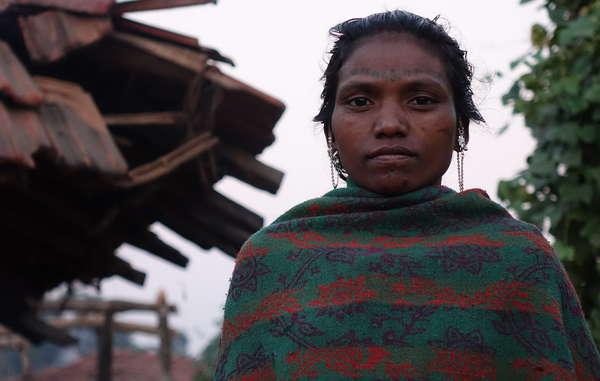
by Deep Green Resistance News Service | Jan 4, 2018 | Colonialism & Conquest
Featured image: This Baiga woman was evicted from Kanha tiger reserve. © Survival International
by Survival International
India’s National Tiger Conservation Authority (NTCA) is coming under increasing pressure over its illegal order banning the recognition of tribal forest rights in tiger reserves. The order prompted Survival International to launch a global tourism boycott in November.
Information released to Survival has revealed that India’s tribal peoples’ Commission (officially called the National Commission for Scheduled Tribes (NCST)) has directly challenged the NTCA’s order in private meetings in Delhi. The Commission demanded that the NTCA suspend any planned evictions of tribal peoples, who have been dependent on and managed their forests for millennia.
After demanding to meet with the NTCA, the Commission argued that the order violates India’s Forest Rights Act – which guarantees tribal peoples’ rights to their forests. It was intended to address the “historical injustice” against tribes and other “traditional forest dwellers.”
In November, representatives of tribal communities met with many human rights and environment activists in Delhi, amidst mounting concern over the NTCA order.
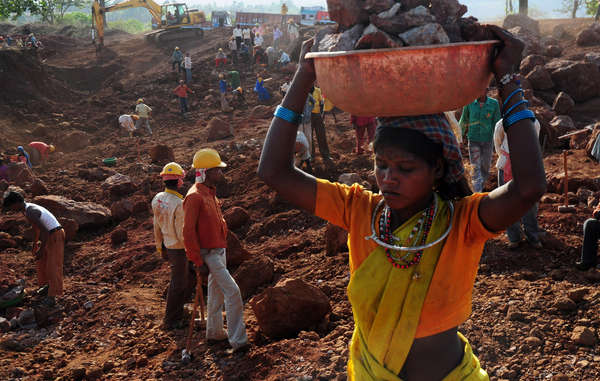
A Baiga woman works for daily wages on Vedanta’s Bodai-Daldali bauxite mine, Chhattisgarh © Sayantan Bera/Survival
J.K. Thimma, a Jenu Keruba man who lives in Nagarhole National Park, and was present at the meeting, said: “The NTCA order is an attack against our culture and our tradition. This is anti-Constitutional and the NTCA have no right to stop the implementation of an Act passed by the Parliament… This is denial for our existence. The order needs to be withdrawn as soon as possible, it is creating fear among all of us.”
Another tribal man, Shankar Barde from Tadoba Tiger Reserve, said: “After years of restrictions and hardships, finally we were told early this year by the district administration that our rights have been recognized. We were excited… but then we were told by the district administration that NTCA order does not allow our rights to be recognized. This is a complete injustice. Dozens of outsiders are earning large sums of money in our backyard while we struggle to even live with dignity.”
Indian law specifically states that the NTCA does not have the power to “interfere with or affect the rights of local people, particularly… tribes.” Tribal rights are under the jurisdiction of the Ministry of Tribal Affairs.
Despite this, conservation authorities have violated the rights of tribal peoples. Across India, tribal peoples endure harassment, coercion, and illegal eviction from their ancestral homelands in the name of conservation.
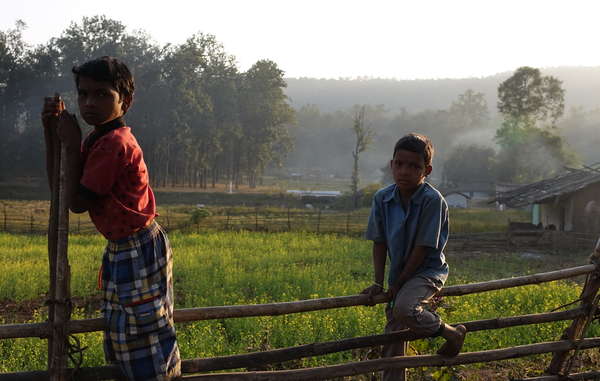
Baiga children. Their village was notified with eviction. Achanakmar Tiger Reserve. © Survival
After eviction, tribal people face lives of poverty and exclusion on the fringes of Indian society. Meanwhile, huge numbers of tourists are then invited into tiger reserves, disrupting tiger habitats and making tigers more vulnerable to poaching.
Survival International is leading the global fight against injustice and abuse in the name of protecting wildlife.
Survival’s Director Stephen Corry said: “This order is an attack on India’s tribal peoples – it’s also illegal. Polluting and destructive industries such as uranium mining and tourism are apparently welcome in tiger reserves, but conservationists in India remain determined to kick tribal people off their land. It’s time they partnered with the best conservationists and guardians of the natural world, and stopped persecuting them. Tribal peoples know their land and its animals better than the conservationists.”
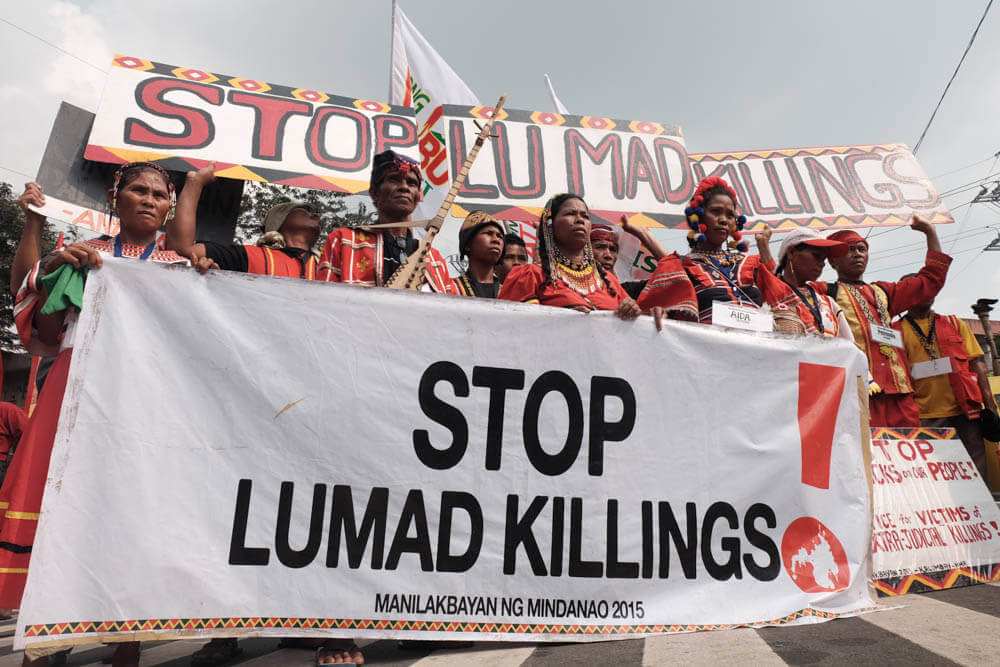
by Deep Green Resistance News Service | Jan 2, 2018 | Colonialism & Conquest
by Pam Tau Lee / Intercontinental Cry
The Lumad are Indigenous Peoples in the southern Mindanao region of the Philippines. The term Lumad is short for Katawhang Lumad (Literally: “indigenous people”), a description officially adopted by delegates of the Lumad Mindanao Peoples Federation founding assembly on June 26, 1986. This grew out of a political awakening among tribes during the martial law regime of President Marcos and reflects the collective identity of 18 Lumad ethnic groups. The assembly’s main objectives was to achieve self-determination and governance for their member-tribes within their ancestral domain in accordance with their culture and customary laws.
The Lumad have a traditional ancestral concept of land ownership which is communal private property. Community members have the right utilize any piece of unoccupied land within the communal territory. Lumad ancestral lands include rain forests, hunting grounds, cultivated and uncultivated land and valuable mineral resources (copper, nickel, gold, chromite, coal, gas, cement) below the land.

For decades the Lumad had been forced to physically defend their right to control their ancestral territories against corporate plunder and militarization. Unable to match up to the armed forces of the government and profiteers the Lumad have had to flee their communities; their land has been seized by multinational corporations and logging companies. Wealthy Filipino migrants and multinationals are planting and exporting palm oil, bananas, rubber and pineapple.
Unequipped to understand the modern land tenure system, the Lumad have established schools in their communities supplying knowledge to young adults and youth on how to protect their rights, property and culture. While these schools have always posed a threat, President Duterte has taken the unprecedented step of directing the Department of Education to close them down and has also encouraged the killing and arrest of Lumad teachers, which continues to go unpunished.
The history of violence and unwarranted (extrajudicial) killings of Lumad at the hands of military, paramilitary, and private security forces is in the hundreds, with the arrest and torture Lumad activists in the thousands. Fifty-six percent of Philippine military have been deployed to the Mindanao region. Today many of the Lumad have sought safety and shelter in evacuation centers where they and other victims of war are crowded into small spaces, lacking sanitary conditions and food, and endure harassment by local police including sexual harassment.
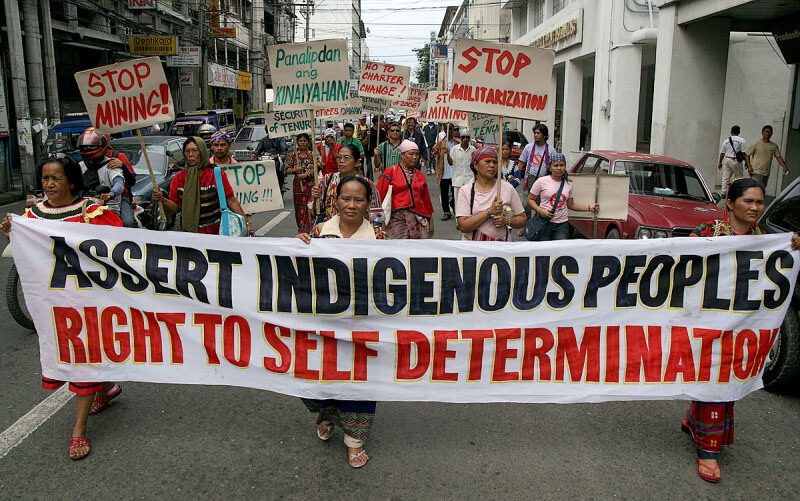
Bolstered by the recent visit of Trump to the Philippines who has promised and delivered increased in military funding to the Philippines, President Duterte has extended martial law on the whole island of Mindanao under the guise of war on terrorism and drugs and has launched a full-scale assault on social justice activists throughout the Philippines, including the Lumad people.
Where there is oppression there is resistance. The Lumad have organized protest actions against mining, extrajudicial killings, and the militarization of their communities, and have led “Manilakbayan” people’s caravans from Mindanao to Manila where they have built unity with Moro and peasant communities and other oppressed sectors in Mindanao and, together, have brought these people’s demands to the national capital. There are some young Lumad that say, because the repression suffered by their community is so bad, at times they consider joining the New Peoples Army. In fact, some Lumad do engage in armed resistance to defend their ancestral lands, as Lumad have done since time immemorial, from fending off logging corporations using spears and native weapons to taking up arms with the New Peoples Army as part of the decades long revolutionary struggle led by the Communist Party of the Philippines. The Lumad struggle continues to take many forms—and as state repression and encroachment on ancestral lands has worsened, Lumad resistance has continued to grow.
In October of 2016, the Lumad people sent messages of solidarity to the tribes and Water Protectors at Standing Rock as they clearly understood the universal common struggle of indigenous to protect the land.

In this moment of intense violence, the International Interfaith Humanitarian Mission 3.0 proposes the following recommendations for the victims of the military operations in Marawi City: Continue relief, medical services and psychosocial intervention for the victims; a just recovery and reparations for homes and properties destroyed; make the Duterte government accountable for the death, displacement of residents and destruction of Warawi City; put people over profit in the rehabilitation of Warawi so that the residents can return to their original communities not profit driven development.
Pam Tau Lee is Chair of the International Coalition for Human Rights in the Philippines (ICHRP) – U.S.
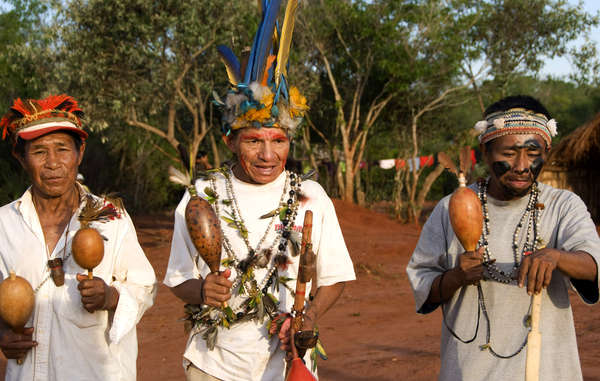
by Deep Green Resistance News Service | Dec 26, 2017 | Colonialism & Conquest
Featured image: The Guarani continue fighting for their land rights despite continuous attacks. © Fiona Watson/Survival International
by Survival International
Ten years ago the Brazilian government signed a landmark agreement with the Guarani tribe, which obliged it to identify all their ancestral lands.
The core objective of the agreement, which was drawn up by the public prosecutors office, was to speed up the recognition of the Guarani’s land rights in the southern state of Mato Grosso do Sul.
However, one decade on, most surveys have not even been carried out and the authorities’ failure to recognize the Guarani’s land rights continues to have a terrible impact on the tribe’s health and well-being.
With no immediate hope of recovering their land and rebuilding their livelihoods, thousands of Guarani are trapped in overcrowded reservations where the prosecutors say there is so little land that “social economic and cultural life is impossible.”
Other Guarani communities live along busy highways or on fragments of their ancestral land, hemmed in by vast sugar cane and soya plantations. They cannot plant, fish or hunt and have no access to clean water.
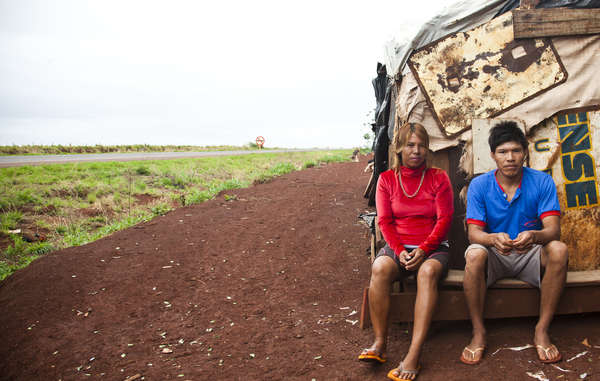
A Guarani-Kaiowa couple sit outside their makeshift roadside settlement of the Apy Ka’y community, near Dourados, Mato Grosso do Sul, Brazil. © Paul Patrick Borhaug/Survival
Health workers report that these communities are suffering from severe side effects of pesticides used by agribusiness. Some communities say their water resources and houses are deliberately sprayed by the ranchers.
A recent study estimated that 3% of the indigenous population in the state could be poisoned by pesticides, some of which are banned in the EU.
Malnutrition especially among babies and young children is common. According to Gilmar Guarani: “Children cry and cannot put up with this situation any more. They are really suffering and are very weak. They are practically eating earth. It’s desperate.”
Mato Grosso do Sul is home to the second largest indigenous population in Brazil, with 70,000 Indians belonging to seven tribes.
Much of their ancestral land has been stolen from them by cattle ranchers and agribusiness, and now they occupy a mere 0.2 % of the state.
John Nara Gomes says: “Today the life of a cow is worth more than that of an indigenous child… The cows are well fed and the children are starving. Before we were free to hunt, fish and gather fruits. Today we are shot by gunmen.”
The despair among the Guarani at the loss of their lands and self sufficient life is reflected in extremely high rates of suicide . In the period 2000-2015 there were 752 suicides. Statistics collected since 1996 reveal a rate that is 21 times greater than the national one. This is probably under-estimated as many suicides are not reported.
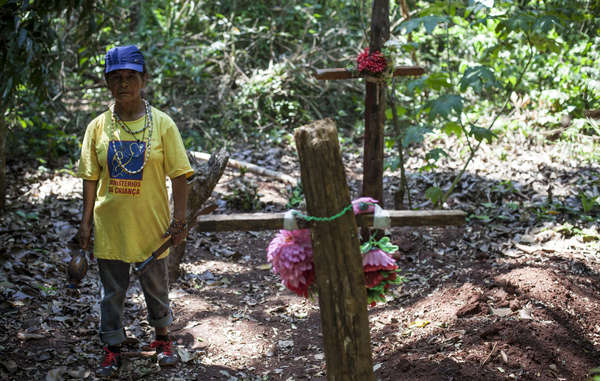
Damiana Cavanha, leader of the Apy Ka’y community, has seen the deaths of three of her children and her husband. She is determinedly planning a reoccupation of their ancestral land where they are buried. © Paul Patrick Borhaug/Survival
The Guarani also face high levels of violence and are constantly targeted by ranchers’ gunmen whenever they attempt to take back parts of their ancestral land. Recent data shows that 60% of all the assassinations of indigenous people in Brazil occurred in Mato Grosso do Sul state.
With a government and congress dominated by the powerful agribusiness sector, the landowners in Mato Grosso do Sul will not cede an inch. Many have resorted to the courts as a delaying tactic, to challenge the identification of Guarani territories. One core Guarani territory has had 57 legal challenges.
Despite this bleak scenario many Guarani vow to fight on: “Brazil was always our land. The hope that feeds me is that our land will be recognized, for without it we cannot care for nature and feed ourselves. We shall fight and die for it” says Geniana Barbosa, a young Guarani woman.
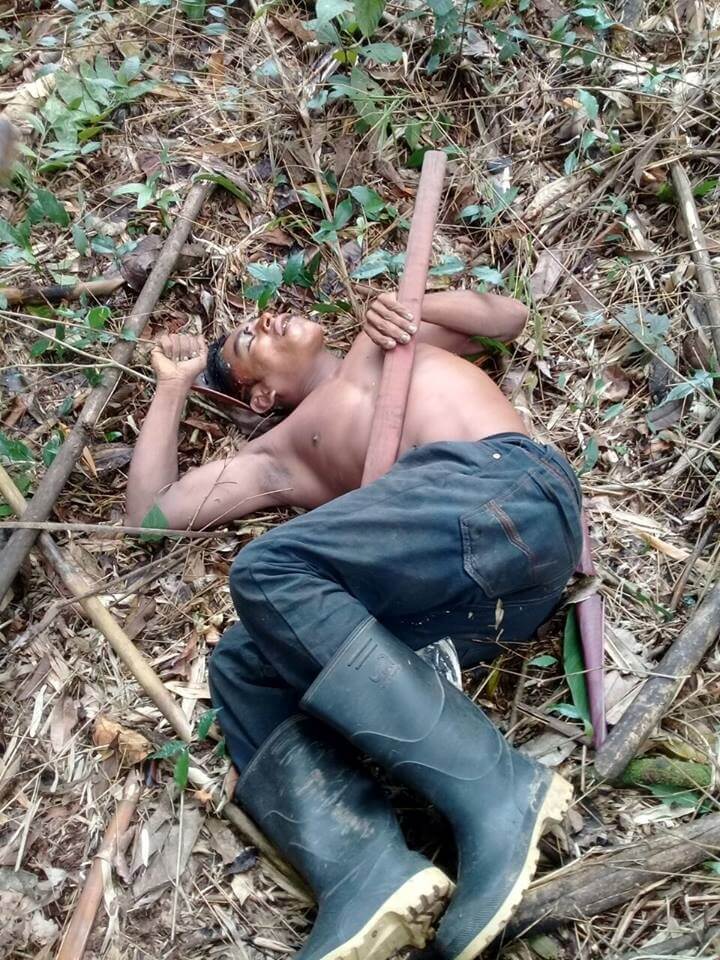
by Deep Green Resistance News Service | Dec 7, 2017 | Colonialism & Conquest
Featured image: Cejudhcan Derechos Humanos
by Courtney Parker / Intercontinental Cry
¡Ya Basta! A phrase known for its political and revolutionary connotations throughout much of the Spanish-speaking world, translates roughly into English as, ‘Enough is Enough!’
It is a statement of finality; a concrete call to action; a heightened call for awareness; and an official call of duty to end cultures of violence and impunity against Indigenous Peoples.
His name was Felipe Perez Gamboa. He was 24 years old.
According to Mark Rivas, who has aided in representing the Moskito Council of Elders at the United Nations, Gamboa was a leader of much distinction among the young people of the community of La Esperanza on the traditional Indigenous frontier region of Moskitia – located on the northern Caribbean coast of colonial Nicaragua and home to the largest tropical rainforest, second only to the Amazon, in the western world.
For his part, Rivas credited Cejudhcan Derechos Humanos – a local NGO whose founder, lawyer Lottie Cunningham, and staff, have been on the receiving end of death threats for their ongoing human rights work in the region – with originally disseminating and confirming the tragedy to the larger community.
The traditional Indigenous frontier regions of Moskitia have been terrorized by mounting acts of deadly colonial violence, stemming from the expanding agricultural frontier and the rigidly nationalist agenda, since 2015.
IC first began reporting on the escalating tragedies in the traditional Indigenous regions in June of 2016.
Readers may refer to previous analyses here and in other outlets concerning the role of the Ortega government, neoliberalism, and the fraudulent banner of ‘Christian Socialism’ the fallen Sandinista leader still attempts to hang over his tenuous authoritarian rule.
As of right now, we can do no more than reach out to the Indigenous rights community in the rest of Latin America, and across the world, with the simple message, made famous by the Zapatsista, that ‘Enough IS Enough’.
It’s time to end this culture of impunity surrounding deadly violence against Indigenous Peoples – in this instance, those who are protecting the last bastions of a biodiverse, climate mitigating rainforest.
¡Ya basta!
¡YA BASTA!
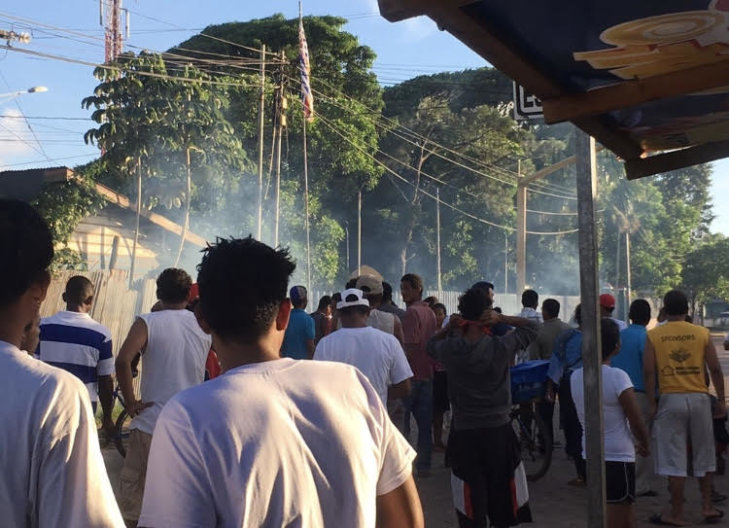
by Deep Green Resistance News Service | Nov 15, 2017 | Colonialism & Conquest
by Brett Spencer / Intercontinental Cry
On Saturday, Nov. 11, members and supporters of the Miskitu indigenous party, Yapti Tasba Masraka Nanih Aslatakanka (YATAMA) crowded into their burnt down compound to celebrate their thirtieth anniversary. Over one thousand people were present, including many from surrounding villages that came to listen to the party’s political leader and congressman, Brooklyn Rivera.
The celebration came just days after riot police and military were flown in from Managua to control dissent following Nicaragua’s municipal elections. YATAMA and its supporters roundly denounced the election results on Nov. 5 that deposed them of control of the municipalities of Bilwi, Waspam, Prinzapolka and Awaltara.
YATAMA’s supporters, who took to the streets in protest of the results—which YATAMA deemed fraudulent—were met with violence by military and paramilitary forces carrying automatic weapons.
“We were protesting electoral fraud,” said the party’s leader, Brooklyn Rivera. “We were protecting our people. We were not expecting the military or the police to attack. Our youth tried to resist the attack, but you cannot fight back with rocks when they have machine guns.”
The violence in Bilwi reached a new low when YATAMA’s headquarters was set on fire Monday night. At least part of the event was caught on film, but no one has taken responsibility for setting fire to the compound.
YATAMA and many residents of Puerto Cabezas-Bilwi say that local residents are not responsible.
Brooklyn Rivera, who was in his office when the building was set ablaze, insists that it was the police and army. “I was inside there when they attacked. It was not the Sandinista youth or local Sandinista members. It was the army and the police who did this, not our local people. This violence was organized from Managua,” he said.
IC confirms that party leadership has been harassed, attacked and threatened by military and paramilitary personal as government forces laid siege to the city. “The burning of the YATAMA house, the radio station and the destruction of the Indian statue came directly from the special forces of the police, not from some local Sandinista group,” said Mr. Rivera. “The leadership of YATAMA is not fighting, we are here accompanying our people.”
These allegations suggest that the post-election unrest in Bilwi is not a local conflict of “Miskitu versus Miskitu,” but rather a government crackdown on indigenous resistance. There are currently one hundred and three political prisoners in Bilwi following the municipal elections, and the arrests of protesters throughout the country show that distrust of the democratic process in Nicaragua is not isolated to the Atlantic Coast.
Mr. Rivera was pleased to have peace during the party’s celebration, and he is already planning a path forward to remain a pillar of support for the indigenous population. “We must rebuild, it is important that our people have staples of communication and resistance like our radio station to keep unity in our communities.”
It has been a difficult week for the party, as it comes to terms with the iron grip of militarization. The aftermath of the election has left many questioning if YATAMA should direct itself away from a political agenda, when each election is met with allegations of fraud and violence.
Mr. Rivera understands this sentiment and frustration, citing a recent resolution by the Inter-American Court of Human Rights, he commented, “We are violating our own rights by participating in this election.”
When asked why the national government has exhausted so much power to prevent YATAMA from succeeding, Mr. Rivera did not hesitate. “They are trying to colonize our people and our land to control our natural resources. We resisted, and now they are trying to totally destroy indigenous organization.”
As relations between YATAMA and the Ortega administration continue to deteriorate, residents are beginning to accuse the government of resorting to the same kind of reactionary violence seen in the 1980s. For now, the city remains peopled with military personnel, as YATAMA plans to reopen its radio station and reconstruct its pillars of resistance.
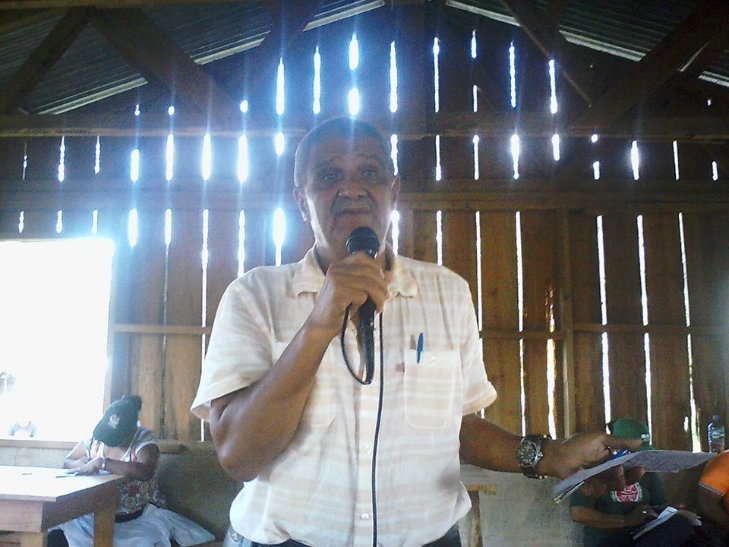
by Deep Green Resistance News Service | Nov 11, 2017 | Colonialism & Conquest
Featured image: Amid reports the Sandinista army has ordered his capture or execution; historic political and spiritual leader of the Indigenous political party of Yatama, Brooklyn Rivera, prepares to brave a public appearance. Photo: Lloyd Lopez
by Laura Hobson Herlihy / Intercontinental Cry
Since the elections on Sunday Nov. 5, Yatama has lost far more than the municipalities of Waspam, Bilwi, Prinzapolka, and Awaltara. At least four people have been killed, dozens have been injured, and 50 have been taken as political prisoners; Yatama’s Miskitu-language radio station and sacred headquarters was burned down; the “indio guerillero” (warrior Indian) statue was destroyed; and Yatama’s own flag was replaced by the flag of the Sandinista nation-state. Their backs are to the wall.
Yatama leaders’ feelings of helplessness does not fit within the Miskitu world-view, however. The Miskitu Peoples still see themselves as successful warriors. They fought alongside the British during the colonial era and were not conquered by the Spanish until 1894, when their Muskitia homeland was incorporated into the Nicaraguan state. As fighters in the US-backed Contra War within the Nicaraguan revolution (1979-1990), the Miskitu were awarded a pluri-ethnic homeland, almost half of the country, with two politically autonomous regions.
So why now in 2017 do the Miskitu feel helpless? In the past, the Miskitu aligned with the British and US governments. Today, they have no international alliances. Only Russia and China are current players in Nicaragua. Chinese mega-projects and Russian military bases and armory, including a recent purchase of 50 tanks, fortify the Ortega government.
On Tuesday, Nov. 7, the Miskitu Yatama sympathizers placed a road block in Sisin, blocking passage of vehicles and haulting commerce between Waspam and Bilwi. Rumors began that Yatama men were arming themselves in rural communities and planned to fight in Bilwi and burn down the entire town of Bilwi (pop. 50,000), the capital of the North Caribbean Autonomous Region. The US Embassy evacuated its Fulbright scholar in Tuapi. Bilwi residents experience anxiety and PTSD.
Speaking with Brooklyn Rivera by phone on the evening of Friday, Nov. 10, IC asked him directly if Yatama is planning to cause violence. He told us, “No, we are the victims of violence. The state is committing violence against us. We are poor indigenous people. We don’t have guns, we have rocks and they have automatic weapons. We can’t fight that.”
When asked if his troops are arming in communities, he responded, “That is just gossip.”
We also asked if Yatama plans to burn down Bilwi. He told us, “No, how can we burn down our home?”
Rivera continued, “Thousands of Miskitu people were not allowed to vote in the municipal elections. Then, the Riot Police from Managua backed by the local Bilwi Police burned down the Yatama radio station and headquarters.”
Rivera, now 65 years old, has served as the highest leader of the Miskitu people since the early 1980s. On the Monday following the 2017 municipal elections, Rivera had a busy day—he escaped from Riot Police and later, the devastating fire at the Yatama house.
Rivera interjected, “Tomorrow at 1:00 in the baseball stadium, we will celebrate Yatama’s 30-year anniversary.” He is the founder and long-term Yatama director. We asked if he plans to attend the celebration. Rivera replied quickly, “Sure, I have to celebrate along with my people.” We pointed out that he may be arrested. He demured, “I am ready for anything that comes. I am the leader of my people, I have done nothing wrong. I haven’t killed anyone.”
Meanwhile, Bilwi sleeps lightly tonight, with the Yatama celebration planned for mid-day. Bilwi is highly militarized, with over 100 riot police roaming the streets along with rogue neighborhood gangs. Any gathering could easily turn into a violent confrontation. The stage is set for a showdown.













